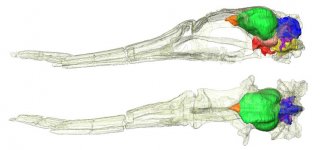Fred Ruhe
Well-known member

Fabien Knoll & Soichiro Kawabe, 2020
Avian Paleoneurology: Reflections on the Eve of Its 200th Anniversary
Journal of Anatomy (advance online publication)
doi: https://doi.org/10.1111/joa.13160
https://onlinelibrary.wiley.com/doi/10.1111/joa.13160
Free pdf:
https://onlinelibrary.wiley.com/doi/pdf/10.1111/joa.13160
Abstract:
In birds, the brain (especially the telencephalon) is remarkably developed, both in relative volume and complexity. Unlike in most early-branching sauropsids, the adults of birds and other archosaurs have a well-ossified neurocranium. In contrast to the situation in most of their reptilian relatives but similar to what can be seen in mammals, the brains of birds fit closely to the endocranial cavity so that their major external features are reflected in the endocasts. This makes birds a highly suitable group for palaeoneurological investigations. The first observation about the brain in a long-extinct bird was made in the first quarter of the 19th century. However, it was not until the 2000s and the application of modern imaging technologies that avian palaeoneurology really took off. Understanding how the mode of life is reflected in the external morphology of the brains of birds is but one of several future directions in which avian palaeoneurological research may extend. Although the number of fossil specimens suitable for palaeoneurological explorations is considerably smaller in birds than in mammals and will very likely remain so, the coming years will certainly witness a momentous strengthening of this rapidly growing field of research at the overlap between ornithology, palaeontology, evolutionary biology and neurosciences.
K E Y W O R D S
brain evolution, endocranial morphology, palaeoneurology
Enjoy,
Fred
Avian Paleoneurology: Reflections on the Eve of Its 200th Anniversary
Journal of Anatomy (advance online publication)
doi: https://doi.org/10.1111/joa.13160
https://onlinelibrary.wiley.com/doi/10.1111/joa.13160
Free pdf:
https://onlinelibrary.wiley.com/doi/pdf/10.1111/joa.13160
Abstract:
In birds, the brain (especially the telencephalon) is remarkably developed, both in relative volume and complexity. Unlike in most early-branching sauropsids, the adults of birds and other archosaurs have a well-ossified neurocranium. In contrast to the situation in most of their reptilian relatives but similar to what can be seen in mammals, the brains of birds fit closely to the endocranial cavity so that their major external features are reflected in the endocasts. This makes birds a highly suitable group for palaeoneurological investigations. The first observation about the brain in a long-extinct bird was made in the first quarter of the 19th century. However, it was not until the 2000s and the application of modern imaging technologies that avian palaeoneurology really took off. Understanding how the mode of life is reflected in the external morphology of the brains of birds is but one of several future directions in which avian palaeoneurological research may extend. Although the number of fossil specimens suitable for palaeoneurological explorations is considerably smaller in birds than in mammals and will very likely remain so, the coming years will certainly witness a momentous strengthening of this rapidly growing field of research at the overlap between ornithology, palaeontology, evolutionary biology and neurosciences.
K E Y W O R D S
brain evolution, endocranial morphology, palaeoneurology
Enjoy,
Fred




